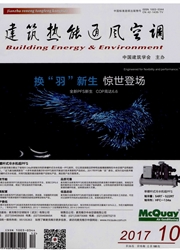

 中文摘要:
中文摘要:
分析了现行的城市热环境调控方法的不足和不同地物的发射率波谱,论述了大气对地物长波辐射的吸收特性,以及辐射能量在地气空间的传输过程,提出了一种新的城市热环境调控方法。为此选择26℃和28℃的土壤、22.6℃的草坪、34℃的水泥路以及39℃的大理石路面,进行了8-13μm波长范围的发射率波谱的辐射能量分析。结果表明:34℃的水泥路辐射的能量最高,22.6℃的草坪辐射的能量最少;大气对34℃的水泥路辐射出能量的吸收最高,即其造成的大气逆辐射效果最强;大气对28℃土壤辐射出的能量吸收最少,即其造成的大气逆辐射效果最弱;28℃土壤透过大气辐射到宇宙空间的能量最高,即其与宇宙空间的辐射换热最强;22.6℃的草坪透过大气辐射到宇宙空间的能量最少,即其与宇宙空间的辐射换热最弱。5种地物对城市热环境的热效应影响程度由强到弱依次为34℃的水泥路、39℃的大理石路面、26℃的土壤、22.6℃的草坪、28℃的土壤。同时还表明地物对城市热环境的影响由其本身的温度和其发射率所决定。
 英文摘要:
英文摘要:
Based on the analyses of the regulating method of current urban thermal environment and the emissive spectral of different features, discussion on absorption characteristics of the long wave radiation of the features by atmosphere and the process of radiation energy transmission in geogas space,this paper proposed a new regulating method for urban thermal environment. The radiation energy of spectral emissivity was analyzed in the wavelength of8 ~ 13 μm by choosing soil at 26℃ and 28℃, lawn at 22.6℃, cement road at 34℃ and marble pavement at 39℃. The results showed that the cement road at 34℃ produced the highest radiation energy while the lawn at 22.6℃ produced the least energy. The radiation energy absorption by atmosphere on the cement road was the highest at 34℃, which meant that the radiated emission effect of atmospheric inversion radiation was the strongest. The radiation energy absorption by atmosphere on the soil was the least at 28℃, which meant the radiated emission effect of atmospheric inversional radiation was the weakest. The radiation energy of the soil through the atmosphere to space was the highest at 28℃, which meant the best radiation heat transfer between soil and space occurred at 28℃. The radiation energy of lawn through the atmosphere to space was the lowest at 22.6℃, which meant the lowest radiation heat transfer between them occurred at 22.6℃. Finally, the influence degrees of five ground objects on the urban thermal environment were ranked as cement road of 34℃〉 marble pavement of 39℃ 〉 soil of 26℃ 〉lawn of 22.6℃ 〉soil of 28℃. In addition,the influence of features on urban thermal environment was determined by itself temperature and emissivity.
 同期刊论文项目
同期刊论文项目
 同项目期刊论文
同项目期刊论文
 期刊信息
期刊信息
